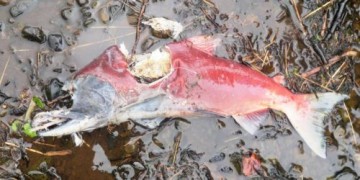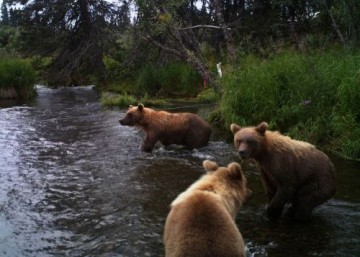I have just spent a week on Lake Aleknagik, part of the Wood River system that empties into Bristol Bay Alaska. Myself and two students (Shannan May-McNally and Allison Dennert) are collecting char (Dolly Varden and Arctic char) for our own work, but are also helping with some sockeye salmon stream surveys out of the U of Washington camp on Lake Aleknagik (one of four such camps in western Alaska).

Lake Aleknagik, AK (E. Taylor)
The Bristol Bay fishery is the largest commercial fishery for salmon in North America where every year literally millions of sockeye salmon (Oncorhynchus nerka) are harvested in net fisheries close to river mouths in Bristol Bay. Since 2004, the total run size has averaged 39 million fish per year, with about 70% harvested in various fisheries. The fishery is a sustainable one, because it is “escapement-based”. That means that no fishing is allowed until the optimal numbers of fish have been determined to have entered the rivers to spawn. Not meeting the “escapement goal” for long term conservation of the various runs is the number one sin of fisheries management here (the second greatest sin is letting too many fish escape as that can overcrowd streams and leads to lost income for the fishing fleet). This year, the escapement goal was 1.2 million sockeye salmon into the Lake Aleknagik watershed; so far 2.7 million have entered the lake (predicting run size is not a perfect science and forecasts have averaged about 7% below the actual run size since 2001).
The fishery is not the only peril faced by migrating salmon. This year water levels in the lake are very low and so are the levels in the streams that are used by spawning salmon.

Sockeye salmon at the mouth of Hansen Creek, AK, in mere cm of water (E. Taylor)
A short video shows sockeye salmon pushing up into Hansen Creek in only a few cm of water. No fear, however; many fish do enter the stream and today we counted more than 12,000 in the 2 km long stream (and it is rarely more than 3-4 m wide) and there are at least 5-10,000 still to enter.
The low water also makes the salmon very vulnerable to predation by the region’s abundant grizzly bears, gulls, and bald eagles. The predator-prey dynamics between sockeye salmon and the bears is the subject of continuing research by Tom Quinn and Aaron Wirsing of the University of Washington. The bears feast on the salmon and are very particular in their tastes; they tend to prefer the brains of males and females (that although very small are rich in fat and degrade less than then muscle tissue as the salmon age in the streams) and the eggs.

A classic “brain-and-hump” predation event on a sockeye salmon by a grizzly bear (E. Taylor)
The bears can have quite an impact on the salmon in this small stream; a short video shows some of the aftermath of a night of bear foraging (careful, the images are graphic!).
The identity of each bear can be determined using DNA analysis of hair samples that are collected by stringing strands of barbed wire at two locations in a series of streams. This way the UW researchers can track the movements and behaviour of individual bears. Over the last two years, at least 55 different bears were identified on the six streams with bear-hair traps. This is of course a minimum estimate as the lake has several more streams and Lake Aleknagik is one of five huge lakes in a single chain.

Three grizzly bears crossing Hansen Creek, Lake Aleknagik, AK. Note the bear-hair wire “trap” in the background (about 8 PM. Courtesy of T. Quinn/A. Wirsing, University of Washington. Taken with a remote, motion-sensitive camera)
At the other end of the spectrum of animal charisma is the lowly maggot (the larval stage of flies) for which the decaying bodies of natural and bear-killed sockeye salmon provide an excellent rearing environment for the legions of flies that will develop from these maggots. Here is a short video of an incredible number of (squirming!) maggots on two salmon carcasses (make sure you are sitting down!). While a bit grim to watch, maggots are essential recyclers of salmon carcasses.
The sockeye salmon is clearly a keystone species in the ecological dynamics of this and other regions in its range. We’ll see our own example of this phenomenon as somewhere between 7 and 73 million sockeye salmon are expected to return to the Fraser River in the summer and fall of 2014. With apologies to my colleague and professor emeritus Tony Sinclair who, in his excellent book Serengeti Story, describes the wildebeest migration of central Africa as perhaps the greatest mass animal migration on Earth – the migration of tens of millions of sockeye salmon (and 100s of millions of all salmon species) from freshwater to the ocean and back to freshwater to spawn across the North Pacific is equally spectacular and ecologically and evolutionarily significant.
